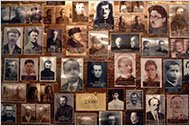
Portraits of those killed hang in a small museum at the site
of a former jail used by Stalin's secret police.
And so a historian named Boris P. Trenin made a plea to officials. Would they let him examine secret archives to confirm that there was a mass grave here from Stalin’s purges? Would they help him tell the story of the thousands of innocent people who were said to have been carted from a prison to a ravine, shot in the head and tossed over?
The answer was no, and Mr. Trenin understood what many historians in Russia have come to realize: Under Vladimir V. Putin, the attitude toward the past has changed. The archives that Mr. Trenin was seeking, stored on the fourth floor of a building in Tomsk, in boxes stamped “K.G.B. of the U.S.S.R.,” would remain sealed.
The Kremlin in the Putin era has often sought to maintain as much sway over the portrayal of history as over the governing of the country. In seeking to restore Russia’s standing, Mr. Putin and other officials have stoked a nationalism that glorifies Soviet triumphs while playing down or even whitewashing the system’s horrors.
Comments:
In many ways, the article is correct. The sources of information for the article are respected historians who have been involved in the study of the history of repressions for many years. However, there are a lot of superficialities and inaccuracies. First of all, it is wrong to mix the situation with the documents on repressed people and “archives of Stalin’s secret services.” The rehabilitation process, the process of studying and publishing information about the victims of terror continues, though weaker these days. The memorial books are being published as before (for the latest integrated version see http://lists.memo.ru/), relatives have the right to study case files, monuments are still well preserved and some new are erected (though not so many).
read more



No comments:
Post a Comment